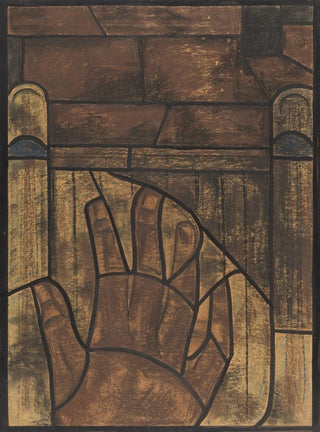Art print | Window project in the north transept of Utrecht Cathedral 41 - Richard Nicolas Roland Holst


View from behind

Frame (optional)
Art print Project of a window in the north transept of Utrecht Cathedral 41 - Richard Nicolas Roland Holst – Captivating introduction
The art print of the Project of a window in the north transept of Utrecht Cathedral 41, an iconic work by Richard Nicolas Roland Holst, immerses us in a universe where sacred architecture meets decorative art. This project, set within a rich historical context, evokes the beauty of medieval stained glass while subtly integrating modernity. Contemplating this piece, the viewer is invited to reflect on the symbolism of light and space, essential elements in the design of places of worship. The window, as an architectural element, does more than illuminate the interior of the building; it becomes a vessel of spirituality, a bridge between the earthly and the divine.
Style and uniqueness of the work
The style of Richard Nicolas Roland Holst is deeply rooted in the Art Nouveau movement, characterized by flowing lines and motifs inspired by nature. In this project, the artist successfully merges these elements with a more modern approach, creating a piece that stands out for its elegance and delicacy. The intricate details of floral motifs, combined with vibrant colors, evoke a sense of serenity and contemplation. The light, filtered through the stained glass, plays a central role, transforming the space into a living tableau where each nuance invites meditation. Holst’s technical mastery is evident in how he harmoniously balances forms and colors, making the window not only a functional element but also a true work of art.
The artist and his influence
Richard Nicolas Roland Holst, a key figure of the early 20th century, left his mark on his era through his innovative approach to decorative art. Influenced by Symbolist currents and artisanal traditions, he always sought to give soul to the materials he used. His work on stained glass, in particular, reflects his desire to combine aesthetics and spirituality. Holst had the opportunity to collaborate with several renowned architects, which allowed him to incorporate his art into large-scale projects, thereby strengthening the collective dimension of his artistic approach. His influence extends

Matte finish

View from behind

Frame (optional)
Art print Project of a window in the north transept of Utrecht Cathedral 41 - Richard Nicolas Roland Holst – Captivating introduction
The art print of the Project of a window in the north transept of Utrecht Cathedral 41, an iconic work by Richard Nicolas Roland Holst, immerses us in a universe where sacred architecture meets decorative art. This project, set within a rich historical context, evokes the beauty of medieval stained glass while subtly integrating modernity. Contemplating this piece, the viewer is invited to reflect on the symbolism of light and space, essential elements in the design of places of worship. The window, as an architectural element, does more than illuminate the interior of the building; it becomes a vessel of spirituality, a bridge between the earthly and the divine.
Style and uniqueness of the work
The style of Richard Nicolas Roland Holst is deeply rooted in the Art Nouveau movement, characterized by flowing lines and motifs inspired by nature. In this project, the artist successfully merges these elements with a more modern approach, creating a piece that stands out for its elegance and delicacy. The intricate details of floral motifs, combined with vibrant colors, evoke a sense of serenity and contemplation. The light, filtered through the stained glass, plays a central role, transforming the space into a living tableau where each nuance invites meditation. Holst’s technical mastery is evident in how he harmoniously balances forms and colors, making the window not only a functional element but also a true work of art.
The artist and his influence
Richard Nicolas Roland Holst, a key figure of the early 20th century, left his mark on his era through his innovative approach to decorative art. Influenced by Symbolist currents and artisanal traditions, he always sought to give soul to the materials he used. His work on stained glass, in particular, reflects his desire to combine aesthetics and spirituality. Holst had the opportunity to collaborate with several renowned architects, which allowed him to incorporate his art into large-scale projects, thereby strengthening the collective dimension of his artistic approach. His influence extends






